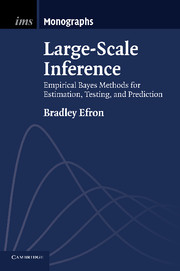Book contents
- Frontmatter
- Contents
- Prologue
- Acknowledgments
- 1 Empirical Bayes and the James—Stein Estimator
- 2 Large-Scale Hypothesis Testing
- 3 Significance Testing Algorithms
- 4 False Discovery Rate Control
- 5 Local False Discovery Rates
- 6 Theoretical, Permutation, and Empirical Null Distributions
- 7 Estimation Accuracy
- 8 Correlation Questions
- 9 Sets of Cases (Enrichment)
- 10 Combination, Relevance, and Comparability
- 11 Prediction and Effect Size Estimation
- Appendix A Exponential Families
- Appendix B Data Sets and Programs
- References
- Index
4 - False Discovery Rate Control
Published online by Cambridge University Press: 05 September 2013
- Frontmatter
- Contents
- Prologue
- Acknowledgments
- 1 Empirical Bayes and the James—Stein Estimator
- 2 Large-Scale Hypothesis Testing
- 3 Significance Testing Algorithms
- 4 False Discovery Rate Control
- 5 Local False Discovery Rates
- 6 Theoretical, Permutation, and Empirical Null Distributions
- 7 Estimation Accuracy
- 8 Correlation Questions
- 9 Sets of Cases (Enrichment)
- 10 Combination, Relevance, and Comparability
- 11 Prediction and Effect Size Estimation
- Appendix A Exponential Families
- Appendix B Data Sets and Programs
- References
- Index
Summary
Applied statistics is an inherently conservative enterprise, and appropriately so since the scientific world depends heavily on the consistent evaluation of evidence. Conservative consistency is raised to its highest level in classical significance testing, where the control of Type I error is enforced with an almost religious intensity. A p-value of 0.06 rather than 0.04 has decided the fate of entire pharmaceutical companies. Fisher's scale of evidence, Table 3.1, particularly the α = 0.05 threshold, has been used in literally millions of serious scientific studies, and stakes a good claim to being the 20th century's most influential piece of applied mathematics.
All of this makes it more than a little surprising that a powerful rival to Type I error control has emerged in the large-scale testing literature. Since its debut in Benjamini and Hochberg's seminal 1995 paper, false discovery rate control has claimed an increasing portion of statistical research, both applied and theoretical, and seems to have achieved “accepted methodology” status in scientific subject-matter journals.
False discovery rate control moves us away from the significance-testing algorithms of Chapter 3, back toward the empirical Bayes context of Chapter 2. The language of classical testing is often used to describe FDR methods (perhaps in this way assisting their stealthy infiltration of multiple testing practice), but, as the discussion here is intended to show, both their rationale and results are quite different.
- Type
- Chapter
- Information
- Large-Scale InferenceEmpirical Bayes Methods for Estimation, Testing, and Prediction, pp. 46 - 69Publisher: Cambridge University PressPrint publication year: 2010
- 1
- Cited by



